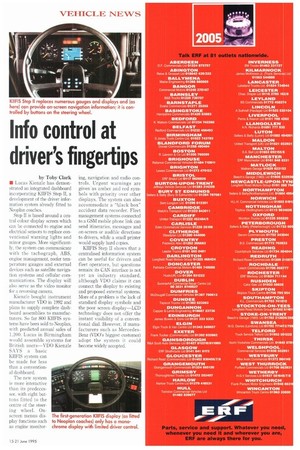Info control at driver's fingertips
Page 17

If you've noticed an error in this article please click here to report it so we can fix it.
by Toby Clark • Lucas Kienzie has demonstrated an integrated dashboard incorporating KIIFIS Step II, a development of the driver information system already fitted to Neoplan coaches.
Step II is based around a central colour display screen which can be connected to engine and electrical sensors to replace conventional warning lights and minor gauges. More significantly, the system can communicate with the tachograph. ABS, engine management, reefer temperature gauges and external devices such as satellite navigation systems and cellular communications. The display will also serve as the video monitor for a reversing camera,
Kienzle bought instrument manufacturer VDO in 1992 and plans to supply complete dashboard assemblies to manufacturers. So far 800 KIIFIS systems have been sold to Neoplan, with predicted annual sales of 1.200. Lucas in Birmingham would assemble systems for British users—VDO Kienzle SAYS a basic KIWIS system can be made for less than a conventional dashboard.
The new system is more interactive than its predecessor. with eight buttons fitted to the centre of the steering wheel. Onscreen menus display functions such as engine monitor
ing, navigation and radio controls. Urgent warnings are given as amber and red symbols with priority over other displays. The system can also accommodate a "black box" accident data recorder. Fleet management systems connected to a GSM mobile phone link can send itineraries, messages and on-screen or audible directions to drivers, while a small printer would supply hard copies.
KIWIS Step II shows that a centralised information system can be useful for drivers and fleet operators, but questions remain: its CAN interface is not yet an industry standard, although VD() claims it can connect the display to existing and proposed external systems. More of a problem is the lack of standard display symbols and the poor screen display—LCD technology does not offer the instant visibility of a conventional dial. However, if manufacturers such as MercedesBenz (VDUs biggest customer) adopt the system it could become widely accepted.
























































































































